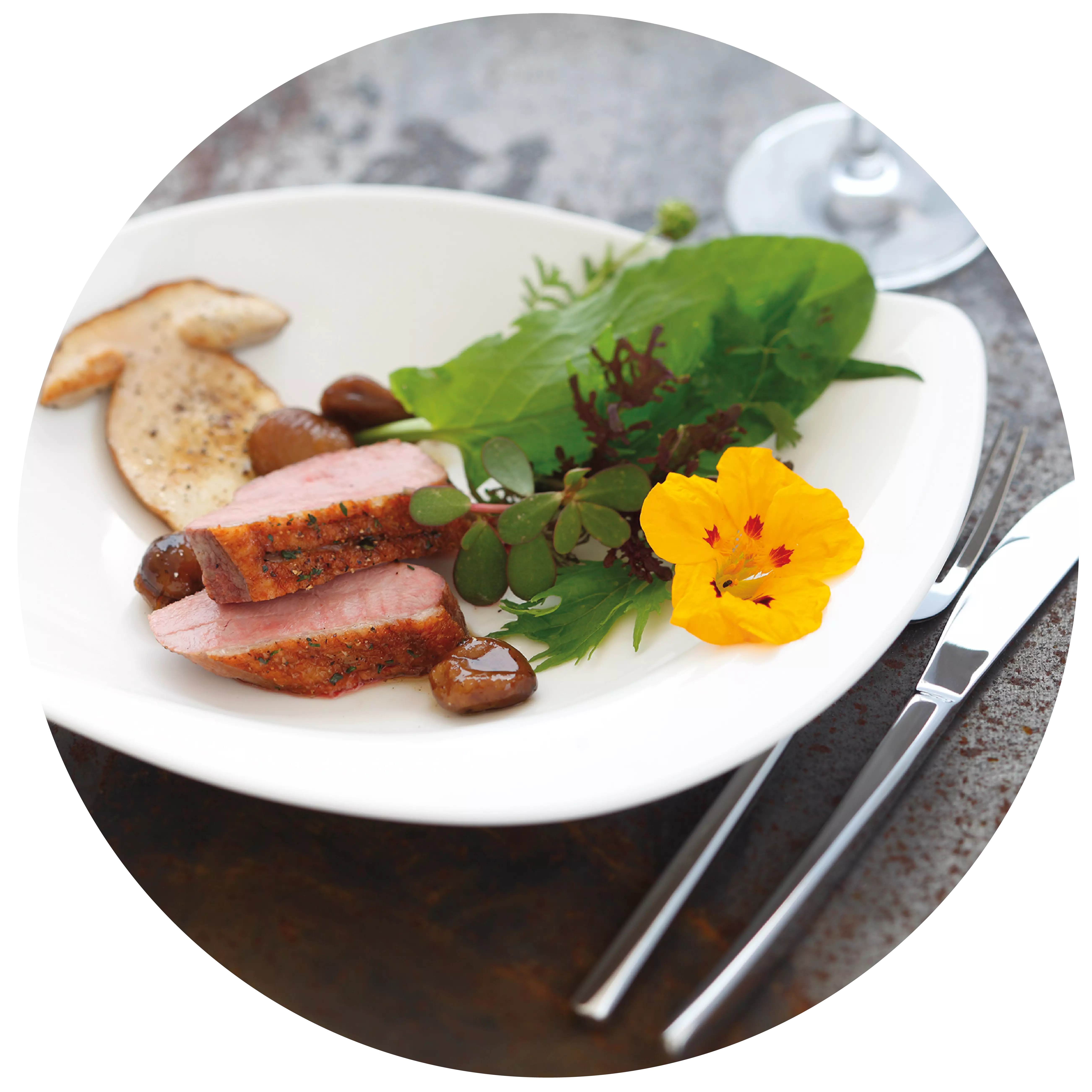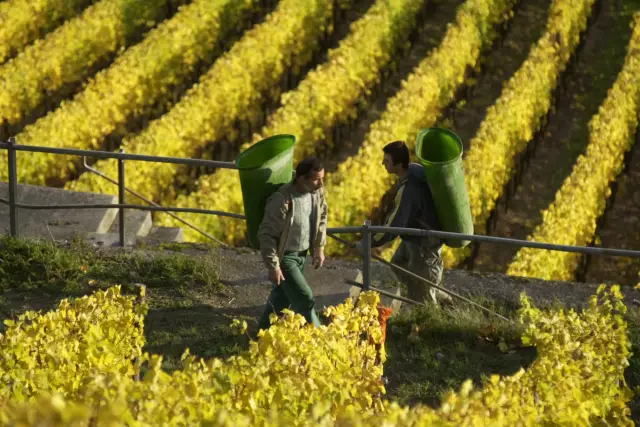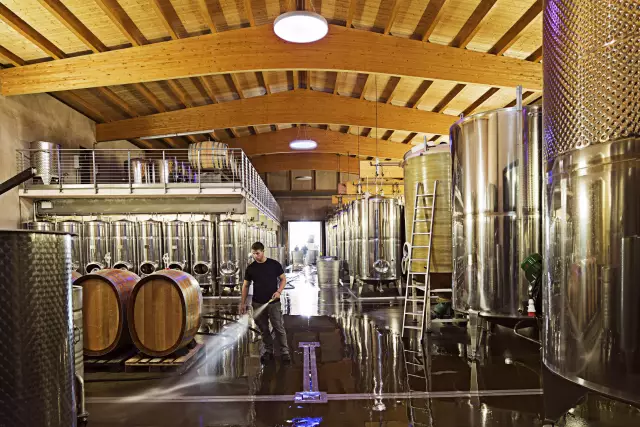PIWI - fungus-resistant vines
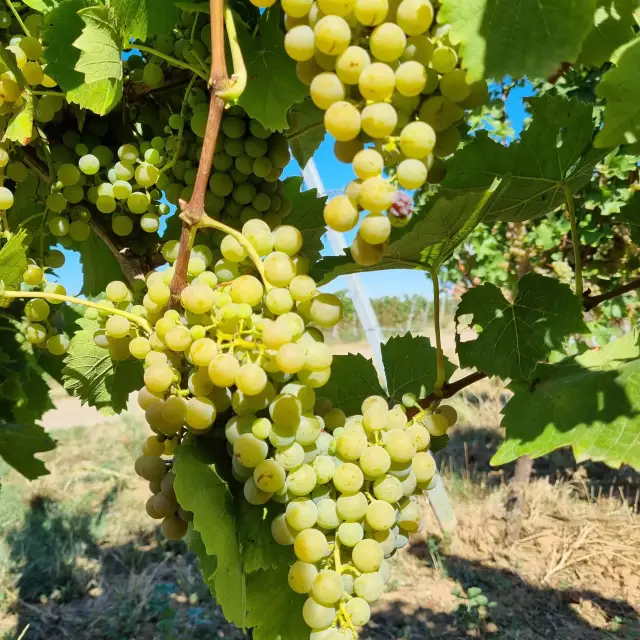
PIWI stands for Pi-lz - Wi-derstandsfähige grape varieties. PIWIs are crosses of American and Asian wild grapevines with European grape varieties.
Facts
-
ca. 3 %
PIWIs have been bred since 1967.
-
1.618 ha
of the vineyards in Germany are currently planted with PIWI.
-
bis zu 80 %
reduzierte Pflanzenschutzmaßnahmen
PIWIs - Fungus-resistant Vines
The term "PiWi", an abbreviation of the German term “Pilzwiderstandsfähige Reben”, stands for fungus-resistant grape varieties that show particularly strong resistance to the vine diseases powdery and downy mildew. Both fungal pathogens were introduced from America with wild grapevines in the 19th century and have since established themselves in European viticulture. Through the classic crossing of American wild grapevines with natural resistance to the pathogens and European grapevines (Vitis Vinifera), which stand for high wine quality, it has been possible in recent years to breed new sustainable grape varieties in Germany that hardly require any plant protection. They combine good flavour with high resistance and help winegrowers to protect the environment.
Breeding PIWIs
As early as about 150 years ago, grape varieties were crossed with American wild species in France and cultivated on a large scale. However, they almost completely disappeared again by the middle of the 20th century. Today, Germany is leading the way in breeding a new generation of these robust varieties. The breeding of a new grape variety is very lengthy and takes about 20 years from the actual crossing to approval. In the meantime, the focus is no longer only on plant health, but also on a variety of other viticultural advantages, such as later ripening, which the varieties are specifically selected for.
What are the advantages of PiWis in viticulture?
The reduction of plant protection measures by up to 80 percent has many advantages for people and the environment. Furthermore, fewer passes in the vineyard can additionally reduce CO2 emissions and soil compaction. For wine producers, this means both time and cost savings.
What are the advantages for consumers?
As consumers, we support sustainable and environmentally friendly wine production. At the same time, new ways are emerging to meet the challenges of ever-increasing climate change and to contribute to the preservation of steep and terraced sites. In addition, the new varieties provide a wider range of enjoyment for wine lovers.
What is the current percentage in Germany?
In Germany, only about 3 percent of the cultivated vineyards are currently planted with PiWis. In addition to many organic wine producers, more and more conventional winegrowing enterprises are increasingly cultivating these new varieties. Of the approximately 3,000 hectares planted with the new varieties nationwide, about half are planted with the red grape variety "Regent", which has been cultivated in Germany since 1995. New red, robust varieties such as "Cabernet Cortis" or "Pinotin" still have less than 100 hectares under cultivation. However, they are increasing just as dynamically from year to year as, for example, the white wine varieties "Cabernet Blanc" or "Souvignier Gris", which together are already cultivated on more than 300 hectares.
The most common PIWI varieties
Every year, the area under cultivation of fungus-resistant grape varieties grows in Germany. PIWIs include Cabernet Blanc, Solaris, Souvignier Gris, Muscaris and Regent. Other varieties are Cabernet Cortis, Calardis Blanc, Laurot, Satin Noir and Sauvignac.
Cabernet Blanc
Area under cultivation: 227 ha (2021)
Crossing: Cabernet Sauvignon x Resistance partner
Flavour profile: Complex, spicy and extract-rich wines with aromas of green pepper, blackcurrant, gooseberry, citrus fruit, apricot and apple. Reminiscent of Sauvignon Blanc.
Solaris
Area under cultivation: 201 ha (2021)
Crossing: Merzling x Gm7493
Flavour profile: Fruity and fragrant wines with aromas of quince, mirabelle, almond and caramel. Solaris is often used for Federweisser or sweet wines, the dry white wines have a Mediterranean character.
Souvignier Gris
Area under cultivation: 131 ha (2021)
Cross: Seyval blanc x Zähringer
Flavour profile: Powerful, full-bodied wines with aromas of honeydew melon, apricot jam and quince juice. Often reminiscent of Pinot Blanc and Pinot Gris with its creamy melt.
Muscaris
Area under cultivation: 98 ha (2021)
Cross: Solaris x Gelber Muskateller
Flavour profile: Slender to full-bodied wines with a lively acidity and the bouquet of a Muscat. The spicy muscat aroma and floral notes will delight lovers of aromatic wines and are suitable both as dessert wines and as accompaniments to Asian cuisine.
Regent
Area under cultivation: 1,671 ha (2021)
Cross: Silvaner x Müller-Thurgau x Chambourcin
Flavour profile: Deep red, colourful and tannic wines with aromas of cherries, plums and red berries. Often also aged in wood or as rosé. High-quality Regent wines benefit enormously from a few years of bottle ageing
Cabernet Cortis
Area under cultivation: 53 ha (2021)
Cross: Cabernet Sauvignon x Solaris
Flavour profile: Deep red to violet wines with aromas of freshly ground pepper and cassis. Very appreciated by fans of french red wine styles from cooler winegrowing regions.
Calardis Blanc
Area under cultivation: n.a.
Crossing: Calardis Musqué x Seyve Villard
Flavour profile: Fine aromas of passion fruit and apple with a spicy bouquet and tangy acidity. The wine is reminiscent of an expressive Rivaner and delights as a light summer wine or as a sparkling wine.
Laurot
Area under cultivation: 5 ha
Cross: Merlot x Seibel x Blaufränkisch x St. Laurent
Flavour profile: Deep dark wines with spicy aromas of wild berries and a fine tannin structure. Reminiscent of Merlot and St. Laurent.
Satin Noir
Area under cultivation: 24 ha
Crossing: Cabernet Sauvignon x Resistance Partner
Flavour profile: Deep red, dense wines with aromas of ripe blackberries and currants, black pepper and dark chocolate with leathery and smoky notes. A Mediterranean wine type with a warm flair of Cabernet Sauvignon or Cabernet Franc.
Sauvignac
Area under cultivation: 77 ha (2021)
Crossing: Sauvignon Blanc x Riesling x Resistance Partner
Flavour profile: An aromatic white wine with delicate aromas of passion fruit, apricot and apple. Sauvignac is reminiscent of both the elegance of a Riesling with a hint of lime or an expressive Scheurebe with aromas of blackcurrant.
Further Links:
More about German grape varieties from Acolon to Pinot Blanc
What does the abbreviation PIWI stand for?
PIWI stands for PIlzWIderstandsfähige grape varieties. These are crosses of American and Asian wild grapevines with European grape varieties.
Varietals

More recipe ideas
with pumpkin and white wine sauce Pasta with pumpkin and white wine sauce
with pumpkin and white wine sauce
- 750 Gramm Butternut-Kürbis(se)
- 3 kleine Zwiebeln
- 2 Zehen Knoblauch
- 1 Becher Crème fraîche
- 250 ml trockener Weißwein
- 500 ml Gemüsebrühe
- 25 Gramm Parmesan oder ähnlicher Hartkäse
- 400 Gramm Spaghetti oder andere Nudeln
- nach Geschmack Salz, Pfeffer, Zucker
- 4 EL Kürbiskerne, evtl. gehackt
- nach Belieben Muskat, Thymian
Sauté the garlic and onions until translucent. Dice the butternut squash and add, season with pepper and sugar. When the cubes are still firm, pour in the white wine and vegetable stock. Continue cooking until the squash is firm to the bite.
In the meantime, cook and drain the pasta.
Add the thyme, nutmeg, salt and crème fraîche to the boiling pumpkin, bring to the boil and thicken. Stir in the parmesan and season to taste. You can also crush some diced pumpkin to make the sauce sweeter.
Arrange the pasta on plates and top with the pumpkin sauce.
Sprinkle with pumpkin seeds.
- Scheurebe (trocken)

with strong red wine Wild boar ragout
with strong red wine
- 800 Gramm Fleisch vom Wildschwein (Keule o. Schulter)
- 80 Gramm Bauchspeck
- 100 Gramm Zwiebeln
- 60 Gramm Karotten
- 60 Gramm Staudensellerie
- 1 TL Tomatenmark
- 200 ml kräftigen Rotwein
- 100 ml Portwein
- 1 Liter braune Wildbrühe
- 1 TL Preiselbeeren
- 1 EL geschlagene Sahne o. Sauerrahm
- 20 Gramm Mehl
- 1 Stück Lorbeerblatt
- je 1 Zweig Rosmarin und Thymian
- 4 zerdrückte Wacholderbeeren
- 1/2 TL Senf
- nach Belieben Salz & Pfeffer
Clean and wash the vegetables and cut into evenly sized cubes.
Remove the fat, skin and tendons from the wild boar meat and cut into 3 cm cubes. Season with salt and pepper and sprinkle with flour. Heat the oil in a frying pan and brown the meat on all sides. Add the vegetables and diced bacon and fry. Add the tomato purée and stir fry. Deglaze with the red wine and port, reduce and pour in the brown game stock. Add the spices to the meat in a small spice bag and leave the ragout to simmer in the oven at 160°C for approx. 1½ hours.
Then remove the pieces of meat, remove the spices, strain the sauce, add the cranberries and mustard and leave to reduce for about 15 minutes. If necessary, thicken with a little cornflour. Serve with the whipped cream.
- Spätburgunder / Pinot Noir (trocken)
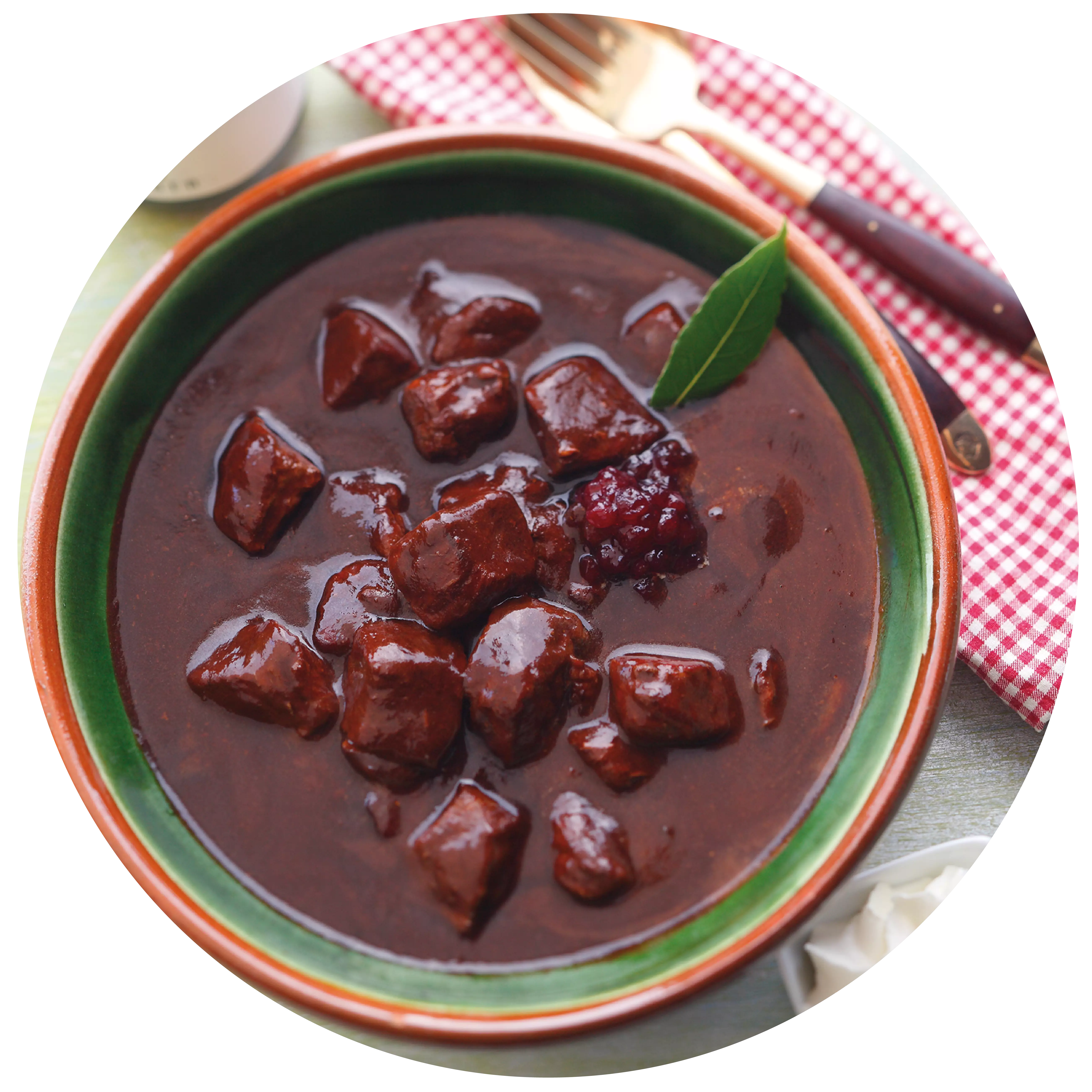
a Christmassy dessert Plum roaster with cinnamon ice cream
a Christmassy dessert
- 1 kg Zwetschgen (frisch oder TK)
- 100 Gramm Zucker
- 0.5 TL gemahlener Zimt
- Eine Prise Nelkenpulver
- 50 ml Pflaumenschnaps
- 50 Gramm dunkler Rohrzucker
- 2 EL alter Balsamicoessig
- 200 Gramm Zucker
- 4 Eigelb
- 500 ml Sahne
Plum rings:
Wash, deseed and quarter the plums. Spread the sugar evenly in a non-stick pan and melt slowly over a medium heat. Increase the temperature and immediately add the fruit, schnapps and spices. Stir until the mixture caramelises.
Stir in the muscovado sugar and balsamic vinegar, spread onto a cold plate after approx. 3 minutes.
<p
<p>Cinnamon ice cream:
Combine the sugar and egg yolks and stir the two ingredients over a bain-marie until frothy.
Whip the cream, then carefully mix both mixtures and add three teaspoons of cinnamon. Carefully mix the cinnamon into the mixture again.
Pour the finished mixture into any (cake) tin or small dish, cover with aluminium foil and place in the freezer for at least three hours.
Place the plums on four deep plates or small bowls, cut off 2 – 3 ice lollies each and place on top, serve immediately.
- Gewürztraminer (trocken)
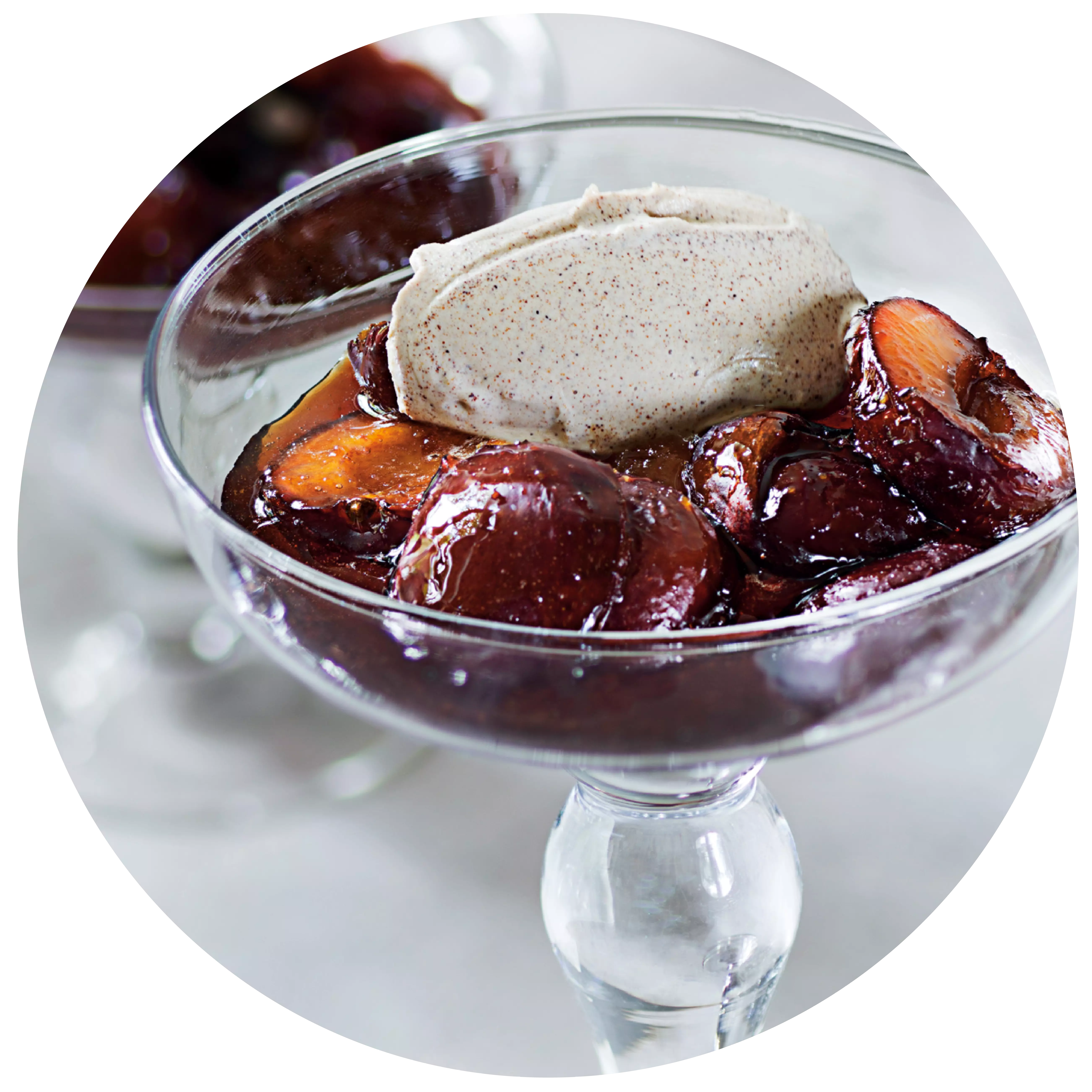
with wild duck breast, porcini mushrooms and glazed chestnuts Herb salad
with wild duck breast, porcini mushrooms and glazed chestnuts
- 150 Gramm Wildkräuter
- 4 EL Olivenöl
- 2 EL Balsamessig
- 8 Stück Wildentenbrüste (a 100g)
- 2 EL Sonnenblumenöl
- 4 EL Honig
- 1 EL Thymian
- 200 Gramm Steinpilze
- 20 gekochte Maronen
- 100 ml Apfelsaft
- 2 El Zucker
- nach Belieben Salz & Pfeffer
Clean, wash and pat dry the wild herbs. Marinate with olive oil and balsamic vinegar and season with salt and pepper.
Preheat the oven to 220°C top and bottom heat. Season the wild duck breasts with salt and pepper, sear on the meat side in a pan with sunflower oil and cook in the preheated oven for about 8 minutes on the skin side. Remove the duck breast, brush the skin side with honey and thyme and roast for another 2 minutes on a high heat until crispy.
Clean the porcini mushrooms and cut into slices. Fry in a pan in oil on both sides, remove and keep warm. Caramelise the sugar in the pan, deglaze with the apple juice and simmer until the caramel has dissolved. Add the chestnuts and add a little more apple juice if necessary.
- Pinot Blanc (trocken)
- Gutedel (trocken)
